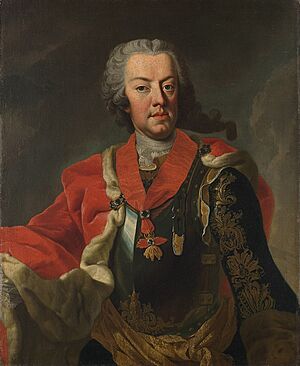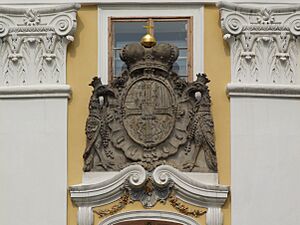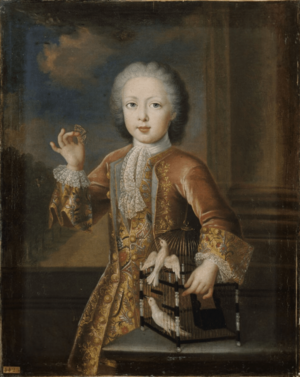Prince Charles Alexander of Lorraine facts for kids
Quick facts for kids Prince Charles Alexander |
|||||
|---|---|---|---|---|---|

Portrait by Martin van Meytens, c. 1743
|
|||||
| Born | 12 December 1712 Lunéville, Duchy of Lorraine, Holy Roman Empire |
||||
| Died | 4 July 1780 (aged 67) Tervuren, Duchy of Brabant, Holy Roman Empire |
||||
| Spouse | Archduchess Maria Anna of Austria | ||||
|
|||||
| House | Lorraine | ||||
| Father | Leopold, Duke of Lorraine | ||||
| Mother | Élisabeth Charlotte d'Orléans | ||||
Prince Charles Alexander Emanuel of Lorraine was a famous general and leader. He was born in Lunéville, a town in the Duchy of Lorraine, on December 12, 1712. He became an important military commander for Austria. He also served as the governor of the Austrian Netherlands, which is now Belgium. He passed away on July 4, 1780, in Tervuren.
Contents
Early Life and Family Connections
Charles was the son of Leopold, Duke of Lorraine. His mother was Élisabeth Charlotte d'Orléans. His older brother, Francis III, Duke of Lorraine, married Maria Theresa. She was the daughter of Emperor Charles VI. This marriage brought Charles Alexander into the service of the Austrian Empire in 1737.
In 1738, his brother Francis made a deal. He traded the Duchy of Lorraine to the former Polish king, Stanisław Leszczyński. In return, Francis received the Grand Duchy of Tuscany. This agreement helped end the War of the Polish Succession.
On January 7, 1744, Charles married Archduchess Maria Anna of Austria. She was Maria Theresa's only sister. This made him Maria Theresa's brother-in-law twice over. Charles and Maria Anna were then made joint Governors of the Austrian Netherlands. Sadly, Maria Anna died later that same year. However, Charles remained popular and continued as governor until his own death in 1780. In 1761, Charles also became the Grand Master of the Teutonic Order.
Military Career and Challenges
During the War of the Austrian Succession, Charles was a main military leader for Austria. He often faced Frederick the Great, the King of Prussia. Frederick's forces were usually better trained and stronger.
At the Battle of Chotusitz in 1742, Charles's army lost. But they managed to cause more damage to the enemy. They also retreated in an organized way. However, he suffered bigger defeats against Frederick in 1745. These were at the Battle of Hohenfriedberg and the Battle of Soor. He was also defeated by Maurice de Saxe at the Battle of Rocoux in 1746.
The Seven Years' War
Even with his past defeats, Charles kept his important military role. His brother, who had a lot of power, helped him stay in command. During Austria's Third Silesian War against Prussia, Charles led the Imperial Army. This war was part of the bigger Seven Years' War.
At the Battle of Prague, he was again defeated by Frederick the Great. But his army caused many losses for the larger Prussian forces. Later in 1757, he defeated a smaller Prussian army at the Battle of Breslau. However, he was completely defeated by Frederick the Great at the Battle of Leuthen. This battle is seen as one of Frederick's greatest victories.
At Leuthen, the Austrian army was much larger than the Prussian army. Yet, they were badly defeated. Charles was very discouraged after this loss. Maria Theresa then replaced him with another general, Count Leopold Joseph von Daun. Charles then retired from military service.
Governor of the Austrian Netherlands
After leaving the army, Charles served as the governor of the Austrian Netherlands. Even though he wasn't the most successful military leader, he was a very good administrator. People in the region liked him a lot. Under his leadership, the Austrian Netherlands thrived. He also took a great interest in the culture of the area.
Architecture and Legacy

Charles Alexander had several beautiful buildings constructed or renovated. He built the Château de la Favorite (Lunéville) as a quiet place to relax.
In Brussels, he had the grand Palace of Charles of Lorraine built. He also oversaw the renovation of Tervuren castle and the Château of Mariemont. Additionally, he ordered the construction of the Château Charles in Tervuren.
Images for kids






